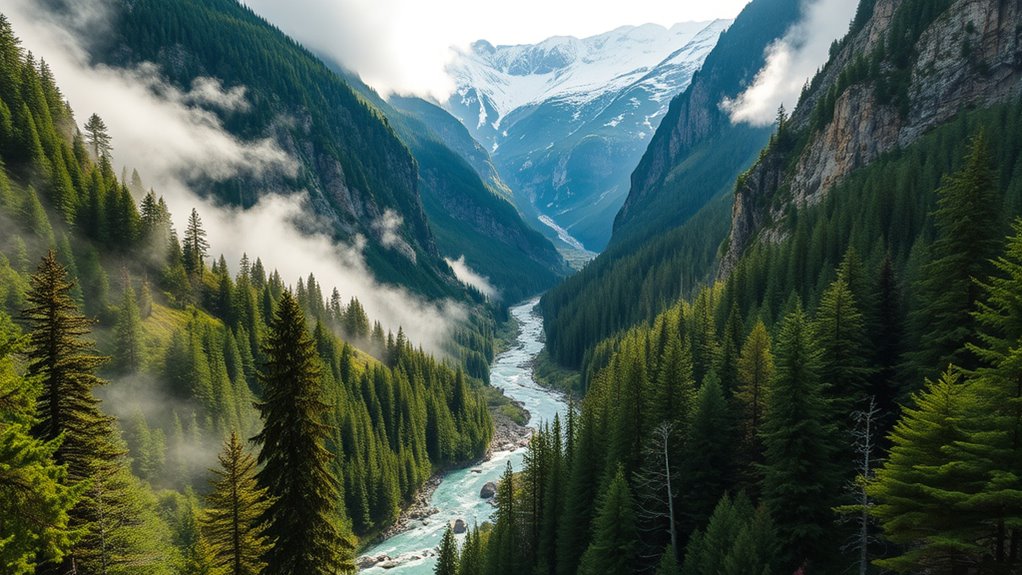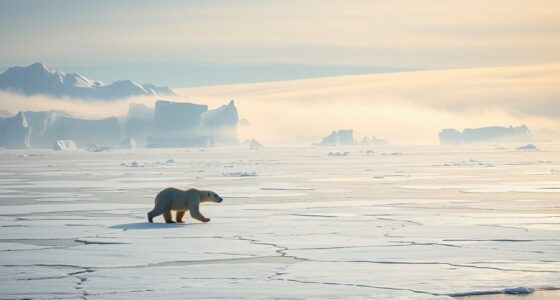Climate refugia are crucial safe zones where wildlife can survive and adapt as global temperatures rise. These areas remain stable despite environmental changes, offering critical habitats through features like microclimates, geographic complexity, and connectivity. Protecting and restoring these sites is essential for biodiversity and ecosystem resilience. Human activities threaten these safe havens, but with better identification, conservation strategies, and community support, their longevity can be secured. Continue exploring to discover how these natural sanctuaries can be preserved for future generations.
Key Takeaways
- Climate refugia are areas that remain relatively stable, providing safe habitats for species amid global warming.
- They enable species survival, migration, and genetic diversity preservation during climate-induced environmental shifts.
- Identifying refugia involves remote sensing, climate modeling, and genetic analysis to locate stable microclimates.
- Protecting and restoring refugia enhances ecosystem resilience and supports biodiversity conservation in a warming world.
- Human activities threaten these safe havens, requiring mitigation measures like habitat connectivity and sustainable land use.
Defining Climate Refugia and Their Significance

Climate refugia are areas that remain relatively stable in their climate conditions despite broader environmental changes. These zones serve as critical sites for climate adaptation, providing safe havens where species can survive and potentially thrive amid changing conditions. Identifying these refugia is essential, and refugia mapping plays a key role in pinpointing where they exist. By understanding the specific characteristics that make a site resilient, conservationists can prioritize protection efforts. Climate refugia act as natural buffers, helping ecosystems maintain their functions and biodiversity. Recognizing their significance ensures that we focus on preserving these crucial areas, facilitating species’ resilience and adaptive capacity in the face of ongoing climate change. Additionally, understanding how pet hair management techniques and tools can influence indoor environments may help mitigate some impacts of animal presence on ecosystems. Moreover, fostering dynamic communication exercises for couples can enhance collaborative efforts in conservation initiatives, strengthening community engagement and collective action. Incorporating adaptive management strategies further ensures that conservation efforts remain effective as environmental conditions continue to evolve. Strategies like refugia identification are vital for targeted conservation planning, ensuring efforts are directed where they are most needed. Utilizing climate data analysis can improve the accuracy of refugia detection and support adaptive conservation planning.
Factors That Make a Site a Climate Refuge

Several key factors determine whether a site can serve as a climate refuge, ensuring it remains relatively stable amid environmental changes. One pivotal element is low climate variability, which helps buffer ecosystems from extreme fluctuations in temperature and precipitation. Stable microclimates, such as shaded valleys or north-facing slopes, provide safe habitats during broader climate shifts. Habitat connectivity also plays a critical role; it allows species to move easily between refugia, promoting genetic diversity and resilience. Additionally, the site’s physical features, like soil quality and water availability, contribute to its stability. Sites with microclimate stability can better support wildlife during rapid environmental changes. Incorporating vetted strategies in site selection enhances the ability of refugia to serve as long-term sanctuaries. Moreover, understanding climate resilience helps identify areas most capable of sustaining ecosystems in the face of ongoing climate change. Recognizing the importance of habitat diversity further reinforces the ecological value of potential refugia, offering multiple resources and niches for various species. A protective buffer zone around these areas can also reduce human disturbances and preserve their ecological integrity. Together, these factors create a sanctuary where wildlife can endure changing conditions, maintain populations, and adapt over time, making these sites essential for conservation efforts in a warming world.
Identifying Potential Climate Refugia Through Science and Technology

Advances in science and technology have revolutionized the way you identify potential climate refugia. You can now analyze genetic adaptation in species to determine their ability to survive changing conditions. By studying genetic markers, you assess which populations are more resilient or capable of evolving quickly. Technology also helps track species migration patterns, revealing where animals naturally relocate to escape warming temperatures. Remote sensing tools, GIS mapping, and climate modeling enable you to pinpoint areas likely to serve as refugia in the future. Combining genetic data with migration insights allows you to create a holistic picture of suitable habitats. Genetic analysis further enhances your capacity to predict species’ responses to climate change, enabling you to target conservation efforts more effectively. Additionally, integrating high-resolution climate models can improve the accuracy of identifying future refugia. These innovations empower you to prioritize conservation efforts effectively, ensuring that critical safe havens for wildlife are preserved amidst ongoing climate change.
Examples of Natural Climate Refugia Around the World

Natural climate refugia are essential sanctuaries where species can endure extreme or changing conditions, often due to unique geographic or ecological features. Around the world, you’ll find remarkable examples of these safe havens. For instance:
Natural climate refugia are vital sanctuaries where species survive extreme and changing conditions worldwide.
- Marine corridors, like those connecting the Coral Triangle, allow fish and coral species to migrate and survive warming seas.
- Alpine sanctuaries, such as the Himalayas, provide cooler habitats for plants and animals retreating from lowland heat.
- Cold-water refugia in Arctic and sub-Antarctic regions preserve unique marine and terrestrial species facing climate change.
- The resilience of these refugia often depends on physical features such as pool hydraulics and other physical features that help buffer temperature extremes and distribute water effectively, highlighting the importance of geographic complexity in climate resilience. These features enhance the microclimates within refugia, creating stable environments for vulnerable species.
These natural refugia demonstrate resilience through geographic features that buffer species from temperature extremes, helping them adapt and persist despite global warming.
The Role of Ecosystem Diversity in Climate Resilience

Ecosystem diversity plays a crucial role in enhancing climate resilience because varied habitats and species interactions create multiple pathways for adaptation. When ecosystems include a mix of habitat mosaics, species can find refuge in different microclimates, buffers, or food sources, increasing their chances of survival amid changing conditions. Genetic diversity within populations strengthens their ability to adapt quickly to new stresses, helping them withstand extreme weather events and shifting climates. By maintaining diverse ecosystems, you promote resilience not just through a variety of habitats but also through the genetic variability that fuels evolution and adaptation. This interconnected diversity acts as a safety net, ensuring ecosystems can recover and persist despite climate fluctuations. Promoting Genetic diversity within populations further enhances their capacity for rapid adaptation and survival. Additionally, habitat heterogeneity provides multiple microenvironments that serve as crucial refuges, further supporting species survival. Recognizing the importance of biodiversity hotspots can help prioritize conservation efforts that maximize resilience. In fact, ecosystem connectivity can facilitate species dispersal and genetic exchange, further bolstering adaptive capacity. Ultimately, ecosystem diversity is fundamental to sustaining wildlife resilience in a warming world.
Conservation Strategies to Protect and Enhance Climate Refugia

To safeguard and improve climate refugia, you need to identify the most critical sites that support vulnerable species. Restoring natural habitats around these areas reinforces their resilience, while creating wildlife corridors improves connectivity. By focusing on these strategies, you help ensure ecosystems can adapt to changing climates effectively. Incorporating natural habitat enhancements that reflect the local environment can also foster community engagement in conservation efforts.
Identifying Critical Refugia Sites
Identifying critical refugia sites is essential for targeting conservation efforts that will effectively buffer species against climate change impacts. To do this, you should focus on key factors such as:
- Genetic diversity within populations, which boosts resilience and adaptive capacity.
- The presence of invasive species that threaten native biodiversity in potential refugia.
- The stability of microclimates and habitat features that provide consistent conditions over time.
- Implementing home improvement strategies can create microclimates that support resilient habitats and help mitigate adverse environmental changes.
Restoring Natural Habitats Effectively
Restoring natural habitats is a crucial strategy for safeguarding climate refugia, as healthy ecosystems provide the microclimates and habitat features necessary for species to survive changing conditions. To do this effectively, focus on reducing habitat fragmentation, which can hinder species migration and adaptation. Restoring corridors and reconnecting fragmented landscapes allow wildlife to move freely in response to climate shifts. Incorporating Fokos, a natural habitat for various species, into restoration efforts can also significantly enhance conservation outcomes. Additionally, integrating biodiversity hotspots into restoration plans ensures that efforts target regions with high levels of endemic species under threat, maximizing conservation impact.
Facilitating Wildlife Connectivity
Enhancing wildlife connectivity is essential for enabling species to adapt to climate change, especially within vulnerable refugia. You can do this by creating and maintaining habitat corridors that facilitate species migration. These corridors act as pathways, allowing animals to move safely between refugia and suitable habitats. To maximize effectiveness, focus on:
- Identifying natural migration routes to connect key refugia
- Restoring degraded habitats to expand corridor networks
- Implementing land-use policies that prevent habitat fragmentation
- Promoting the use of organic and natural practices in land management to support ecosystem health and resilience. Additionally, understanding the ecological processes involved in habitat connectivity can help optimize conservation efforts and ensure long-term success.
Challenges in Preserving Climate Refugia Amid Human Activities

Human activities like land development and resource extraction put climate refugia at significant risk. Urban expansion often encroaches on these essential areas, disrupting ecosystems. Addressing these challenges requires balancing development needs with effective conservation efforts. Implementing protective measures can help mitigate some of these impacts and preserve these critical habitats for future generations. Additionally, establishing navigation tools and monitoring systems can aid in tracking changes and ensuring the resilience of these habitats over time. Incorporating natural materials into conservation strategies can also enhance habitat stability and support native species’ survival.
Land Development Pressures
As development projects expand and infrastructure projects multiply, preserving climate refugia becomes increasingly difficult. Urban sprawl encroaches on these essential habitats, fragmenting ecosystems and reducing their ability to support wildlife. Industrial pollution further degrades these areas, contaminating water and soil, and threatening species already under stress. To understand the scope, consider these key challenges:
- Rapid urban sprawl replacing natural landscapes
- Industrial pollution compromising habitat quality
- Infrastructure development fragmenting ecosystems
These pressures make it harder for climate refugia to remain resilient, forcing species into smaller, less viable areas. Without careful planning and regulation, human activities will continue to threaten these last safe havens, jeopardizing their role in helping wildlife adapt to a warming world.
Resource Extraction Conflicts
Resource extraction activities, such as mining, drilling, and logging, directly threaten the integrity of climate refugia by encroaching on these protected areas. Mining conflicts often lead to habitat destruction and pollution, disrupting the delicate ecosystems that species rely on to survive in a warming world. Logging disputes can result in deforestation and fragmentation, making it harder for wildlife to migrate or find refuge. These human activities compete with conservation efforts, escalating tensions over land use. You must recognize that such conflicts undermine the resilience of climate refugia, which are essential for preserving biodiversity. Addressing these challenges requires balancing resource needs with habitat protection, ensuring that climate refugia remain safe havens amid increasing human pressures.
Urban Expansion Effects
Urban expansion poses a significant challenge to preserving climate refugia by encroaching on these essential habitats. As urban sprawl continues, natural areas shrink, reducing available safe havens for wildlife. You should be aware of three key impacts:
- Loss of habitat due to land conversion for development.
- Increased city heat, which worsens the effects of climate change in remaining refugia.
- Fragmentation of ecosystems, making it harder for species to migrate and adapt.
City heat, driven by dense infrastructure and reduced greenery, intensifies the warming effect, threatening the survival of species in climate refugia. To protect these indispensable areas, managing urban sprawl and mitigating city heat become critical steps in conserving wildlife amid ongoing human expansion.
The Impact of Climate Change on Existing Refugia Sites

Climate change is increasingly threatening existing refugia sites, which have long served as essential sanctuaries for vulnerable species. Rising temperatures and altered precipitation patterns push species to migrate beyond traditional boundaries, challenging their survival within refugia. As habitats shift, some species can’t keep pace, risking local extinctions. Genetic adaptation becomes critical, allowing populations to evolve traits better suited to changing conditions, but this process takes time and isn’t guaranteed. Without intervention, climate change may fragment refugia, reducing their effectiveness as safe havens. You need to recognize that these sites are under pressure from both climate impacts and species’ limited capacity to adapt quickly enough, emphasizing the importance of protecting and managing refugia to preserve biodiversity amid ongoing climate shifts.
Future Directions for Research and Policy in Climate Refugia Management

Addressing the growing threats to existing refugia requires a proactive approach to research and policy development. To guarantee their longevity, focus on:
Proactive research and policies are vital to ensuring the longevity of climate refugia.
- Advancing research on genetic adaptation, helping species evolve resilience to changing conditions.
- Developing flexible policy frameworks that incorporate climate projections and prioritize conservation efforts.
- Promoting the integration of climate refugia into land use planning and protected area networks.
How Communities Can Support the Preservation of Climate Safe Havens

You can help protect climate safe havens by supporting local conservation projects and encouraging responsible land use. Educating your community about the importance of these areas motivates collective action. When everyone gets involved, you strengthen efforts to preserve these essential refuges for the future.
Supporting Local Conservation Efforts
Communities play a vital role in preserving climate refugia by actively supporting conservation efforts that protect these essential habitats. Your involvement can directly influence species migration, ensuring animals move safely between refuges, and help maintain genetic diversity within populations. To make an impact, consider these actions:
- Support local conservation programs that protect critical habitats.
- Volunteer for habitat restoration projects to enhance refuge resilience.
- Advocate for policies that prioritize climate refugia preservation and species migration corridors.
Promoting Sustainable Land Use
By adopting sustainable land use practices, communities can play a crucial role in safeguarding climate refugia. You can encourage farmers to implement eco-friendly agricultural practices that preserve soil health, reduce runoff, and minimize habitat disruption. Promoting land management strategies that maintain natural vegetation helps create buffers around refuge areas, protecting wildlife from climate stresses. Investing in renewable energy sources, like solar or wind power, reduces dependence on fossil fuels, decreasing pollution and greenhouse gas emissions that threaten these habitats. Proper zoning and land planning ensure development doesn’t encroach on critical climate refugia. Your community’s support for sustainable agriculture and renewable energy adoption directly contributes to the preservation of these last safe havens, helping wildlife adapt and survive in a warming world.
Educating Community Members
Educating community members about the importance of climate refugia empowers them to take meaningful actions to protect these essential habitats. When you understand how species migration depends on ecological corridors, you can help support efforts to preserve these pathways. Here are three ways you can make a difference:
- Raise awareness about the role of climate refugia in supporting species migration and ecological corridors.
- Participate in local conservation initiatives focused on protecting habitats that serve as safe havens.
- Advocate for land-use policies that prioritize the preservation of ecological corridors connecting climate refugia.
Frequently Asked Questions
How Do Climate Refugia Influence Local Human Communities and Economies?
Climate refugia positively impact you by supporting indigenous livelihoods and eco-tourism development. They attract visitors, which boosts local economies and creates new job opportunities. You might see increased investments in conservation and sustainable practices, helping preserve culture and environment. As communities benefit from eco-tourism, you can enjoy authentic experiences while ensuring wildlife and natural habitats remain protected, fostering long-term resilience in the face of climate change.
Can Climate Refugia Serve as Sources for Species Reintroduction Elsewhere?
Yes, climate refugia can serve as sources for species reintroduction elsewhere. Their high restoration potential and preserved genetic diversity make them essential for maintaining healthy populations. You can leverage these refugia to reintroduce species to areas where they’ve declined or vanished, helping restore ecosystems. By protecting these refugia, you guarantee they retain their resilience and genetic variation, making them reliable sources for broader conservation and reintroduction efforts.
What Are the Potential Conflicts Between Conservation and Land Development Near Refugia?
You can’t have your cake and eat it too, especially near refugia. Land use and zoning decisions often clash with conservation goals, risking habitat loss and fragmentation. Developers seek to maximize profits, while conservationists aim to protect vulnerable species. This conflict requires careful planning to balance growth with ecosystem preservation, ensuring refugia remain safe havens rather than zones of conflict. Prioritizing sustainable land use helps safeguard these critical wildlife sanctuaries.
How Do Invasive Species Affect the Stability of Climate Refugia?
Invasive species threaten the stability of climate refugia by outcompeting native plants and animals, disrupting existing ecosystems. You might notice invasive species spreading rapidly, reducing biodiversity and altering habitat conditions. This destabilization hampers the refugia’s role as a safe haven, making it harder for native species to survive. To maintain ecosystem stability, controlling invasive species becomes essential, ensuring these critical refuges can effectively support wildlife amid climate change.
What Funding Options Are Available for Climate Refugia Research and Protection Efforts?
You can access various funding mechanisms and grant opportunities to support climate refugia research and protection efforts. Look into government agencies like the National Science Foundation or the Department of the Interior, which offer grants specifically for environmental conservation. Additionally, explore private foundations and international organizations that focus on climate change and biodiversity. Applying for these grants can help you secure the resources needed to identify, preserve, and manage climate refugia effectively.
Conclusion
You can play a crucial role in protecting climate refugia, which are vital for wildlife survival. Did you know that only 10% of natural habitats currently serve as refugia, yet they hold 80% of species at risk? By supporting conservation efforts and sustainable practices, you help guarantee these safe havens persist. Together, we can safeguard biodiversity and give wildlife a fighting chance in our warming world.








